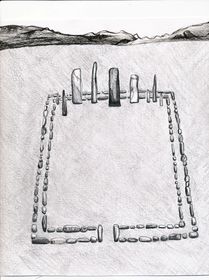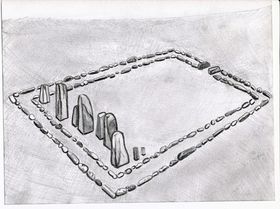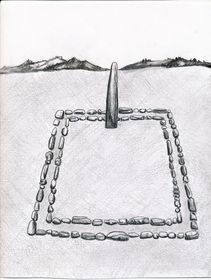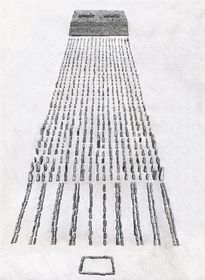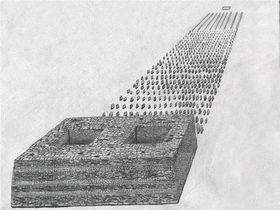II.1) Stelae and accompanying structures
One of the most captivating types of archaic archaeological site in Upper Tibet consists of stelae, pillars or menhirs either in a solitary aspect or in groups forming special kinds of arrays. In this work, descriptions of 110 sites featuring pillars are presented. The Tibetan generic term doring is applied to pillars of all species in Upper Tibet. These standing stones vary greatly in size (15 cm to 2.4 m in height) number and layout, which is indicative of a fairly broad variety of ritual applications and cultural contexts. As with the dokhang residential monument, pillars without inscriptions reached their highest level of development on the plateau in Upper Tibet. Pillars exhibiting different morphological characteristics were erected hewn or unhewn, and were made from a diverse assortment of rocks (including igneous, volcanic, metamorphic, and sedimentary). Pillars, whatever their function, were planted firmly in the ground by first excavating a hole to accommodate 30% to 50% of the total length of the stone. Over the centuries, through the agency of gravity and geomorphologic change, it is common for pillars to have collapsed or to tilt in a downhill direction. Gently and even radically inclined pillars are encountered at many sites. Pillars in the Upper Tibetan archaic archaeological context appear to have functioned as political monuments for clans and chieftains, cultic sites for the worship of deities, good fortune enhancement and harm reduction instruments, and as memorials and ritual dispensation sites marking cemeteries.
II.1a) Isolated pillars
Pillars that stand alone or in groups (two to twenty in number) in isolation from other structures are commonly distributed in the Jangtang west of 90° 45΄ E. longitude. Lone pillars are also found in a few locations in Gugé and Purang. The function, significance and chronology of pillars that stand alone, without the benefit of other structures that can serve as interpretive benchmarks, are very difficult to assess. It appears that some pillars, grouped in rows, heralded the existence of cemeteries. Lines of pillars that probably mark grave sites are found in places like Gyaplung Doring (C-13) Doring Gyaplung (C-23) and Dzatsok Doring (C-28). There are probably other examples among the pillar sites recorded where physical evidence of the tombs has been effaced from view. Individual pillars are also known from certain grave sites (see D-72). Solitary pillars, especially those in Gugé, appear to have had a cult function pertaining to the worship of local deities (see C-14, C-169, etc.). Some of these stelae are still used in the placation of indigenous spirits at annual community rites (such as the lhasöl, held during sowing and harvesting). Other solitary pillars could have been erected as territorial markers; such is the local oral tradition surrounding Chunkhor Doring (C-25). Finally, it is also plausible that some of what now appear to be isolated groups of stelae were in fact erected inside quadrate stone enclosures, the signs of which have been obliterated.
II.1b) Pillars erected within quadrate enclosures
Pillars erected within square or rectangular walled enclosures represent one of the most distinctive types of archaic ceremonial monuments in Upper Tibet. Due to their unique morphological characteristics and territorial specificity, they serve to delineate the paleocultural domain of the region. Pillars erected within a quadrate enclosure were most often built in open areas such as plains, large benches or wide slopes endowed with long vistas to the east. They are customarily founded on well-drained level or very slightly sloping gravelly or sandy terrain, with a ridge or hill serving as a western backdrop. Some sites overlook lakes, rivers and marshes, while others are found in waterless areas. One or more pillars are invariably set on the west side of a stone enclosure, in close proximity to the inside edges of the bordering walls. In most cases, the enclosures are generally aligned in the cardinal directions and less frequently, in the intermediate directions. One to more than a dozen pillars was planted inside a single enclosure. Pillars vary significantly in shape and size. They can be tabular, four-sided, three-sided, or irregularly-shaped, and range in height from 20 cm to 2.4 m. Tabular pillars usually have their two broad sides oriented north-south. They have both flattened and pointed tops. Some pillars were carefully cut into regular shapes, while at most sites, raw stones were used for installation. Pillars erected inside a quadrate enclosure were constructed from a wide variety of locally occurring lithic materials, and it is not uncommon for more than one type of rock to have been used in construction, creating structural elements of contrasting colors and textures.
At some locations, one or more walls of the enclosures are raised above the surrounding terrain in order to maintain a level interior. Rectangular enclosures regularly have longer dimensions east to west. An exception is encountered in certain rectangular enclosures in far western Tibet, which have longer north to south dimensions. This constitutes a regional design variation with no other significant morphological differences observed. The enclosures vary in size between 3 m by 3 m and 14 m by 22 m. The walls forming the perimeter of the enclosure normally contain parallel courses of stones, and range between 40 cm and 80 cm in thickness. Most enclosures are constructed of unhewn upright stone slabs or blocks (10 cm to 80 cm in length), which are embedded in the ground. These stones are level with the ground surface or are elevated above it to a height of 10 cm to 40 cm. However, some enclosure walls are composed of two to four vertical layers of blocks and may be as much as 50 cm in height. It is not uncommon to find both superficial and built-up wall sections in a single enclosure. In some examples of the enclosure, there is an opening in the middle of the east wall, which appears to have functioned as an aperture of ritual importance.
Most commonly, there is just one walled pillar monument per site but at some places there are two, which are spaced 10 m to 1 km apart. In more recent times, a significant minority of the pillar sites was used in apotropaic and fortune-bestowing rituals associated with the indigenous pantheon. Pillars erected inside quadrate enclosures are frequently found in proximity to other funerary structures such as slab wall arrays, burial tumuli and other types of tomb and funerary ritual superstructures. Funerary structures are discernable at more than one third the total number of walled pillar sites surveyed. It seems likely that most of these pillar monuments originally accompanied some form of burial, the signs of which are not necessarily visible on the ground surface. It does not appear, however, that the pillars were raised directly on top of tombs.
Pillars erected within quadrate stone enclosures appear to have functioned as memorials or commemorative monuments for the deceased, who were buried in outlying tombs. Special rites may have taken place inside the enclosures such as the depositing of offerings and the lighting of sacrificial fires. Archaeological investigations show that analogous enclosures of the Scytho-Siberians and Turks were used for such purposes. The erection of pillars may have acted as a symbol of temporal power, linking the tribal leadership with their ancestral rulers and deities.1 A localized clan or cultic function connected to the levers of social and political power is suggested by the solid distribution of the monument throughout its territorial scope.2 Dunhuang and Bön funerary accounts suggest that the erection of pillars occurred in rites designed to lure the souls of the deceased to the center of ritual operations, so that they could be sent on to the ancestral afterlife. The funerary pillars of the Bön literary tradition are known as ‘receptacles of the soul’ (layi ten).
Pillars erected within enclosures or in isolated rows occur in the north Inner Asian funerary archaeological record as well. The morphological, functional and geographic aspects of the late Bronze Age and Iron Age pillar monuments of the steppes indicate that they have significant cultural and ecological affinities to the Upper Tibetan pillars erected in quadrate enclosures. These interrelationships are examined in Zhang Zhung: Foundations of Civilization in Tibet. Linkages as cognate ideational, technological and environmental innovations suggest the kind of time frame in which the Upper Tibetan pillar monuments originated and developed. Nevertheless, the doring of Upper Tibet represent unique conceptions of design, spatial ordering and ritual practice, which are indicative of a cultural entity distinct from its northern neighbors. Cross-cultural archaeological comparisons with the Scytho-Siberians encourage the view that the walled pillars sprang up in Upper Tibet as early as the beginning of the first millennium BCE. Unlike the tumultuous steppes with their great clashes of peoples and the attendant disintegration of cultures, the pillars of Upper Tibet seem to have survived as a relict cultural form perhaps through the imperial period. The geographic isolation of Upper Tibet from the epochal human movements of north Inner Asia, and what appear to have been its relatively stable economic and cultural systems, argue in favor of the long-term persistence of the monument.
Pillars erected inside quadrate enclosures are well distributed throughout Upper Tibet, west of 89º 26΄ E. longitude and south of 33º 30΄ N. latitude, with the exception of Transhimalayan Gugé. The geographic bounds of this pillar subtype correspond to what we might call the ‘core area’ of Upper Tibetan archaic cultural entity. The absence of these emblematic monumental features in the far eastern Jangtang (or in any other region of the Tibetan Plateau) indicates that these regions had different cultural and/or ethnical compositions. As the pillars erected in quadrate enclosures possess definitive design and constructional features, setting them apart from the archaeological monuments of adjoining regions, they are admirably suited to serve as territorial markers delineating the heart of the Upper Tibet paleocultural zone. It would appear, based on the monument’s areal distribution, that this unique Upper Tibetan ecological and cultural domain is tantamount to the prehistoric and early historic Zhang Zhung cultural sphere of the Tibetan textual tradition.3
II.1c) Quadrate arrays of pillars with appended edifices
Vertically set stones, erected in rows aligned in the cardinal directions to produce large formations of pillars, share the same geographic scope as the pillars erected inside enclosures. These pillar arrays were also usually constructed on level or slightly inclined ground with deep vistas to the east. They are found on the edges of plains or on broad esplanades, often bounded in the west by a ridge or mountain slope. In most instances, fields of standing stones appear to have been established in areas remote from human settlement, for many of the sites are devoid of permanent sources of potable water. In a single complex, there were between several hundred and 3000 pillars set into the ground in more or less evenly distributed rows. Considerable attention was devoted to insuring the orientation of the pillars and the integrity of the grid pattern.
The concourses of stelae vary greatly in size, and cover between 30 m² and 4000 m². The stelae range in height from 15 cm to 1.4 m, with an average protrusion above the ground of around 40 cm. These pillars were made from either natural pieces of stone or perhaps from rocks that were roughly cut into shape. The smaller specimens tend to be pointed. Many of the larger stelae are tabular in form and have their broad sides aligned in a north-south direction. They are made from a variety of stones, depending on the geological makeup of the locale. The rows of standing stones are positioned 40 cm to 1.2 m from each other, as are the individual stones that make up a row. At some sites, slabs of stone (10 cm to 1.2 m in length) were embedded in the ground edgewise, often in parallel courses, around the array of standing stones. The same slab walls are sometime used to subdivide the concourse of pillars into smaller units. These 20 cm to 40 cm thick slab walls are flush with the surface or protrude above it to a maximum height of 20 cm. There are also numerous instances of double-course slab walls, extending 3 m to 30 m east of the pillar arrays, to create an extensive grid of parallel structures which are also aligned in the cardinal directions.
One to six meters west of an array of pillars is what appears to have been a mortuary temple cum tomb edifice. The lines of pillars seem to have almost reached the tomb but, at many sites, proximate rows have been uprooted. Like the pillars themselves, these masonry structures are usually aligned in the cardinal directions. They vary greatly in size and complexity, ranging between 3 m to 65 m in length. The tallest surviving temple-tombs are 4.3 m (Yül Khambu, C-143) and 3.5 m (Shasha Pelkhang, C-145) in height, but originally they may have been substantially taller. Although none of the top-most part of these structures has endured, they were almost certainly built with flat roofs, probably of an all-stone corbelled composition. In the larger edifices, the windowless walls are up to 2.5 m in thickness, creating relatively small, hermetically sealed, interior spaces. This clearly indicates that these structures were not built for habitation. Where significant elevations have survived, it can be discerned that most were four-sided structures, the larger of which were divided into two to five or more compartments. It appears that these robustly built internal spaces were burial or reliquary chambers. Taller walls of the temple-tombs slightly taper inwards in the Tibetan ‘fortress’ style of construction, a design feature not well articulated in other Upper Tibet archaic monument types. Walls were constructed of coursed-rubble of variable-sized stone blocks and slabs whose exterior faces were hewn smooth. Masonry courses were laid flat, as well as in a distinctive ‘herringbone’ pattern, whereby two intervening courses were set diagonally into the wall. To reinforce larger walls, courses of thin bond stones were also employed at strategic levels. The interior walls appear to have been built of finer masonry than the exterior walls. Small quartz crystals and pieces of red sandstone are found scattered at some sites; these may have been employed as decorative or ritual elements.
In the local oral tradition, the monolithic arrays and accompanying mausolean tombs are often accorded a funerary function associated with the ancient Mön tribe. Local reports hold that human skeletal remains were discovered at certain sites, indicating that they did indeed function as necropoli. Other types of tomb superstructures and pillars are quite often found in close proximity to the pillar complexes, corroborating this view. It would appear that the edifices appended to the pillars functioned as tombs and as temples where mortuary and perhaps commemorative rites were conducted for the interred. The ritual function of the fields of standing stones is a mystery. There is some speculation among local residents that each pillar represented a single individual, as in the constituent members of an ancient army. Some drokpa believe that under each pillar are the remains of an individual. Such an impression emphasizes the corporate or community-based aspects of the monument as important centers of ritual dispensation and social interaction. The pillars may have ritually functioned to capture the souls of the deceased before their send-off to the afterlife. This old Tibetan funerary culture motif would seem particularly relevant if the quadrate arrays of pillars with appended edifices were founded to honor those fallen in battle. According to the Bön archaic funerary texts, those who die from violent causes (driwo) require elaborate apotropaic and fortune-bestowing rites to be carried out in order to commend the soul to the ancestral paradise. Markers (to), probably represented by stone cairns or pillars in some cases, are recorded in these funerary texts as being essential in pressing down (nönpa) potentially harmful chthonic spirits such as the lu and si. This kind of rite was carried out by priests known as durshen and dri bönpo.
The effort made to align the edifices and networks of pillars in the cardinal or intermediate directions is in itself highly significant. I am inclined to see this orientation as reflecting important religious preoccupations pertaining to the celestial sphere. Solar, lunar and/or sidereal alignments and calendrical parameters may have been incumbent in the spatial bearing of the structures. According to Bön ritual literature, many of the deities of Zhang Zhung were associated with celestial and meteorological phenomena, and similar religious traditions may also be implicit in the careful alignment of the pillars and edifices.
The relative scarcity of arrays of pillars appended to temple-tombs (the obliteration of specimens notwithstanding) and the highly elaborate nature of their construction allude to an exclusive social sphere. It seems most likely that these necropoli are where the elite of society (the regional priestly and/or ruling classes) carried out ritual functions for those of similar rank, and where they were ultimately inhumed. Such cultural activities are likely to have been conducted with the large-scale cooperation and participation of local communities. The existence of great complexes scattered across Upper Tibet from 89° 26΄ E. longitude west to the southeastern extent of Gugé (80° 47΄) may also indicate that there were multiple geographic centers of political power. A dispersed dominion is supported by the legends of the Zhang Zhung kings occupying various residences across much of Upper Tibet.4 Such archaeological and textual evidence buttresses the widely circulating hypothesis that Zhang Zhung was a tribal confederacy or decentralized state, where political power was largely in the hands of the constituent regions and/or clan factions.
The extensive use of pillars in Inner Asia is first attested in south Siberian Okunev burial sites (middle of second millennium BCE). Standing stones associated with burial sites are also prevalent at pre-Scythian (1200 BCE to 800 BCE) and Scytho-Siberian sites (800 to 300 BCE) in north Inner Asia. These pillars were erected in close proximity to funerary ritual enclosures, burial mounds and other types of mortuary structures. At southern Siberian Tashtyk sites (first to sixth century CE) one or even several rows of pillars with broad sides directed north and south are a common funerary architectural feature. Prolific use of standing stones is found at early Turkic burial sites (sixth to eighth century CE) of Mongolia, Tuva, the Altai, Kirgizia, Kazakistan and Xinjiang. These so-called bulbul stones can number up to 157 in a single row and are usually planted on the east side of slab wall enclosures (used for ritual or cremation purposes at early Turk burial grounds). The bulbul stones are 10 cm to 70 cm in height and spaced 50 cm to 5 m apart.5 As the pillar arrays of Upper Tibet share general technological, morphological and ritual traits with those found in the steppes, it suggests that certain religious conceptions pertaining to death diffused between the regions as part of a pan-cultural heritage.6 My findings indicate that Bronze Age ethnical commonalities, as well as the widespread development of nomadic pastoralism and the riding horse in the first millennium BCE, are likely to account for the fusion of certain abstract cultural elements in the steppes and Upper Tibet.
Clearly, however, the pillar arrays of Upper Tibet represent a unique form of funerary monument that developed and flourished only in this region. Nowhere else in Inner Asia did such large numbers of orderly arranged stelae arise at a single site. Moreover, the above-ground massively built mortuary temple-tombs of the Upper Tibetan context represent a remarkable cultural achievement, reflecting a good deal of indigenous technological and cultural sophistication. Foot bones extracted from a grave cleaved in two by a seasonal torrent at Khangmar Dzashak (C-160) have yielded a conventional radiocarbon age of 740 BCE +/- 40 years. This chronometric evidence indicates that such sites were established as funerary complexes by the first third of the first millennium BCE. The incorporation of the dated tomb between two pillar complexes at Khangmar Dzashak encourages us to view the stelae and appended temple-tombs as an integral part of the same spectrum of funerary traditions. As for the demise of this monument type: it seems unlikely that after Pugyel Tibet’s annexation of Zhang Zhung in the seventh century CE, such large displays of indigenous power and prestige would have been tolerated or even economically feasible. In any event, with the coming of Buddhist domination at the turn of the second millennium CE, the use of the arrays of pillars and temple-tombs must have been completely discontinued.
II.1d) Domestic Pillars
In 1998, a pillar was found erected in a still standing all-stone habitation at Dodrilbu (B-13). This 65 cm high pillar is found fixed in the small western-most room of this dokhang, which has much of its roof still intact.7 With the discovery of a second pillar in the poorly preserved remains of residential structure RS4 at Dingdum (D-64) by Mark Aldenderfer in 2001, a new class of Upper Tibetan pillar was positively documented.8 The analogous ground plan and relative geographic orientation of the RS4 and Dodrilbu structures indicate that the domestic pillars belong to the same Upper Tibetan cultural horizon. Aldenderfer’s dating of collateral organic remains at Dingdum to circa 550 BCE to 100 BCE, point to the erection of pillars inside habitations as having an Iron Age context. The habitations in which they were discovered are the largest in their respective residential sites, seemingly reflecting the high social status of the occupants. Isolated pillars may have been raised as part of local cults connected to the worship of territorial and clan deities.
